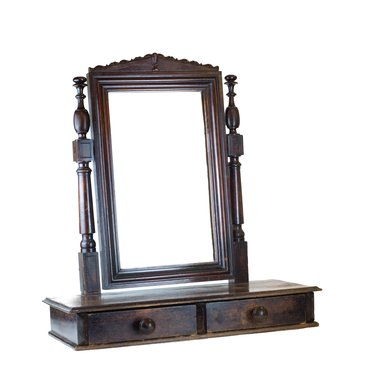The museum acquired this painting in 1930 together with the portrait of nobleman Dmitry Bychkov from the academician of painting Ivan Kulikov. For the longest time, there was no additional information about this artwork. However, after studying the archival data, the museum workers managed to relate the female and male portraits with each other.
A young, slim woman dressed in an elegant blue dress is depicted in the painting. Her name, Varvara Nikolayevna, was mentioned in the documents of 1844 — 1859, though nowhere was specified from which noble family or which Murom family she descended. Thus, researchers suggested that the woman was not Murom-born.
In Varvara Nikolayevna’s dowry, it was listed that she had land plot in the Tambov Governorate and “in Moscow, Prechistenskaya part of Denezhny Pereulok, a wooden house under number 258”. Therefore, she could be Moscow-born. In the research “Necropolis of the city of Murom” the experts found out the years of her life and surname: “Bychkova Varvara Nikolayevna (1799-29.5.1862) — noblewoman”.
Varvara Bychkova was buried in the Savior Monastery in Murom, in the same cemetery as Dmitry Bychkov’s mother. Having known the year of her birth, the researchers calculated that she had gotten married at the age of 20, 1820. In December of that year, she gave birth to her first child, a son Nikolay. Later, she had three more children: Iliodor in 1823, Zinaida in 1828, and Mikhail in 1834.
Bychkova’s hairstyle and dress depicted by the artist in the portrait, allowed to determine the time of its creation — the late 1820s — 1830s. At that particular time, the women waved their hair in spirals (kiss-curls) and wore their hair in a bun on the back of the head. This popular hairstyle was called “Apollo’s knot”. The portrayed woman wore the Biedermeier style dress, fashionable in the 19th century, with a lowered shoulder line and accent large sleeves, which were called buffs.
Bychkova is dressed and coiffured after the latest fashion of that time, but her garment is quite simple. Her shoulders are covered, and there are no big and expensive jewelry decorations on her dress. The attributes that could reveal the social status of the model are absent. The artist sought to create the virtuous image of a woman from the provincial environment. Bychkova’s calm face expression and the modest pose emphasized this image: most commonly, the married women were portrayed in such a manner.
A young, slim woman dressed in an elegant blue dress is depicted in the painting. Her name, Varvara Nikolayevna, was mentioned in the documents of 1844 — 1859, though nowhere was specified from which noble family or which Murom family she descended. Thus, researchers suggested that the woman was not Murom-born.
In Varvara Nikolayevna’s dowry, it was listed that she had land plot in the Tambov Governorate and “in Moscow, Prechistenskaya part of Denezhny Pereulok, a wooden house under number 258”. Therefore, she could be Moscow-born. In the research “Necropolis of the city of Murom” the experts found out the years of her life and surname: “Bychkova Varvara Nikolayevna (1799-29.5.1862) — noblewoman”.
Varvara Bychkova was buried in the Savior Monastery in Murom, in the same cemetery as Dmitry Bychkov’s mother. Having known the year of her birth, the researchers calculated that she had gotten married at the age of 20, 1820. In December of that year, she gave birth to her first child, a son Nikolay. Later, she had three more children: Iliodor in 1823, Zinaida in 1828, and Mikhail in 1834.
Bychkova’s hairstyle and dress depicted by the artist in the portrait, allowed to determine the time of its creation — the late 1820s — 1830s. At that particular time, the women waved their hair in spirals (kiss-curls) and wore their hair in a bun on the back of the head. This popular hairstyle was called “Apollo’s knot”. The portrayed woman wore the Biedermeier style dress, fashionable in the 19th century, with a lowered shoulder line and accent large sleeves, which were called buffs.
Bychkova is dressed and coiffured after the latest fashion of that time, but her garment is quite simple. Her shoulders are covered, and there are no big and expensive jewelry decorations on her dress. The attributes that could reveal the social status of the model are absent. The artist sought to create the virtuous image of a woman from the provincial environment. Bychkova’s calm face expression and the modest pose emphasized this image: most commonly, the married women were portrayed in such a manner.



